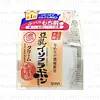What's inside
What's inside
 Key Ingredients
Key Ingredients

 Benefits
Benefits

 Concerns
Concerns

 Ingredients Side-by-side
Ingredients Side-by-side

Water
Skin ConditioningGlycerin
HumectantDipropylene Glycol
HumectantParaffinum Liquidum
EmollientDimethicone
EmollientCetyl Alcohol
EmollientTriethylhexanoin
MaskingHydrogenated Poly(C6-14 Olefin)
EmollientLactococcus/Hyaluronic Acid Ferment Filtrate
Sodium Hyaluronate
HumectantHydrolyzed Hyaluronic Acid
HumectantHydroxypropyltrimonium Hyaluronate
Hydrolyzed Sodium Hyaluronate
Skin ConditioningSodium Acetylated Hyaluronate
HumectantSodium Hyaluronate Crosspolymer
HumectantAphanothece Sacrum Exopolysaccharides
AbsorbentAllantoin
Skin ConditioningPalmitic Acid
EmollientCetyl Phosphate
EmulsifyingArginine
MaskingPhenoxyethanol
PreservativeCarbomer
Emulsion StabilisingDisodium EDTA
Hydroxyethylcellulose
Emulsion StabilisingButylene Glycol
HumectantPentylene Glycol
Skin ConditioningWater, Glycerin, Dipropylene Glycol, Paraffinum Liquidum, Dimethicone, Cetyl Alcohol, Triethylhexanoin, Hydrogenated Poly(C6-14 Olefin), Lactococcus/Hyaluronic Acid Ferment Filtrate, Sodium Hyaluronate, Hydrolyzed Hyaluronic Acid, Hydroxypropyltrimonium Hyaluronate, Hydrolyzed Sodium Hyaluronate, Sodium Acetylated Hyaluronate, Sodium Hyaluronate Crosspolymer, Aphanothece Sacrum Exopolysaccharides, Allantoin, Palmitic Acid, Cetyl Phosphate, Arginine, Phenoxyethanol, Carbomer, Disodium EDTA, Hydroxyethylcellulose, Butylene Glycol, Pentylene Glycol
Water
Skin ConditioningSqualane
EmollientStearic Acid
CleansingStearyl Alcohol
EmollientGlycine Max Seed Extract
Skin ConditioningButylene Glycol
HumectantTocopheryl Acetate
AntioxidantXanthan Gum
EmulsifyingMilk Ferment
Skin ConditioningCarbomer
Emulsion StabilisingSodium Hydroxide
BufferingAlcohol Denat.
AntimicrobialPalmitic Acid
EmollientCetearyl Alcohol
EmollientAluminum Starch Octenylsuccinate
AbsorbentGlycerin
HumectantCitric Acid
BufferingCyclohexasiloxane
EmollientBeeswax
Emulsion StabilisingMethylparaben
PreservativeGlyceryl Stearate
EmollientCyclopentasiloxane
EmollientWater, Squalane, Stearic Acid, Stearyl Alcohol, Glycine Max Seed Extract, Butylene Glycol, Tocopheryl Acetate, Xanthan Gum, Milk Ferment, Carbomer, Sodium Hydroxide, Alcohol Denat., Palmitic Acid, Cetearyl Alcohol, Aluminum Starch Octenylsuccinate, Glycerin, Citric Acid, Cyclohexasiloxane, Beeswax, Methylparaben, Glyceryl Stearate, Cyclopentasiloxane
 Reviews
Reviews

Ingredients Explained
These ingredients are found in both products.
Ingredients higher up in an ingredient list are typically present in a larger amount.
Butylene Glycol (or BG) is used within cosmetic products for a few different reasons:
Overall, Butylene Glycol is a safe and well-rounded ingredient that works well with other ingredients.
Though this ingredient works well with most skin types, some people with sensitive skin may experience a reaction such as allergic rashes, closed comedones, or itchiness.
Learn more about Butylene GlycolCarbomer is a polymer of acrylic acid. Its main role is to create a gel consistency.
A high amount of carbomer can cause pilling or balling up of products. Don't worry, most products contain 1% or less of carbomer.
Glycerin is already naturally found in your skin. It helps moisturize and protect your skin.
A study from 2016 found glycerin to be more effective as a humectant than AHAs and hyaluronic acid.
As a humectant, it helps the skin stay hydrated by pulling moisture to your skin. The low molecular weight of glycerin allows it to pull moisture into the deeper layers of your skin.
Hydrated skin improves your skin barrier; Your skin barrier helps protect against irritants and bacteria.
Glycerin has also been found to have antimicrobial and antiviral properties. Due to these properties, glycerin is often used in wound and burn treatments.
In cosmetics, glycerin is usually derived from plants such as soybean or palm. However, it can also be sourced from animals, such as tallow or animal fat.
This ingredient is organic, colorless, odorless, and non-toxic.
Glycerin is the name for this ingredient in American English. British English uses Glycerol/Glycerine.
Learn more about GlycerinPalmitic Acid is a fatty acid naturally found in our skin and in many plant and animal sources. In cosmetics, it is usually derived from palm oil. It serves many purposes in skincare, acting as a cleanser, emollient, and emulsifier.
As an emollient, palmitic acid helps soften and smooth the skin by preventing water loss. In cleansers, it helps remove oil and dirt while creating foam.
Its emulsifying properties help stabilize products by keeping water and oil-based ingredients from separating.
This may not be suitable for fungal acne-prone skin, as fatty acids like this can sometimes trigger breakouts in sensitive individuals.
Learn more about Palmitic AcidWater. It's the most common cosmetic ingredient of all. You'll usually see it at the top of ingredient lists, meaning that it makes up the largest part of the product.
So why is it so popular? Water most often acts as a solvent - this means that it helps dissolve other ingredients into the formulation.
You'll also recognize water as that liquid we all need to stay alive. If you see this, drink a glass of water. Stay hydrated!
Learn more about Water